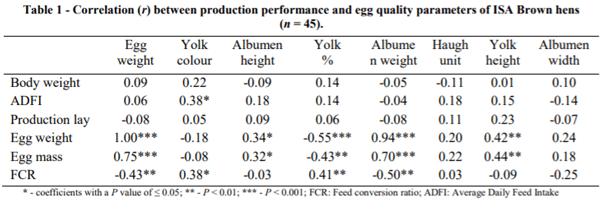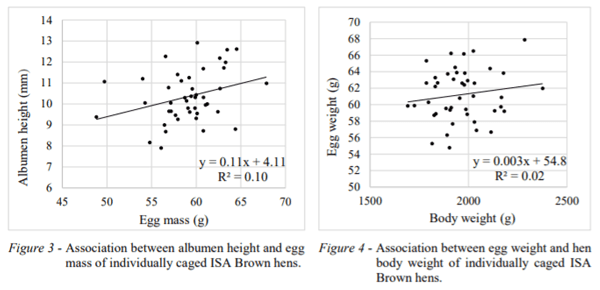I. INTRODUCTION
The profitability of the egg industry at commercial farm level is influenced by key production traits such as feed consumption, feed efficiency and egg quality. These measures of profitability are primarily controlled by genetics, but are also influenced by environmental factors leading up to the onset of lay and beyond. Consequently, inconsistency in voluntary feed intake and hen body weight can result in variations in feed efficiency, egg production and egg quality (Roberts et al., 2015). Recent studies suggest that important relationships exist between egg quality and some production traits such as feed intake, FCR and body weight, in mid lay hens (Akter et al, 2018), whereby hens ranked as feed inefficient lay eggs with lower Haugh unit scores. While many studies have focused on describing the genetic causes of variation in production traits in hens (Liu et al, 2018), there is an information gap on how production traits such as feed intake, laying persistency and feed efficiency relates to egg quality in individually caged ISA Brown hens and little work has been done to describe the extent and effect of these relationships. The objective of this study was to investigate the relationships between variations in production traits of individual laying hens and the quality of eggs produced from the same hens.
II. METHODOLOGY
Without any exclusion criteria, forty-five individually caged ISA Brown hens, aged 25 weeks, were randomly selected from a 450-layer hen observational study and monitored for six weeks for feed intake, egg production, egg weight and egg quality characteristics. Hens were individually caged in 25 × 50 × 50 cm layer cages. Shed temperature, photoperiod and lighting were managed according to the ISA Brown management guide. A wheat and soybean based layer mash diet containing 16% protein was offered ad libitum in metal feeders. Water was offered ad libitum through automatic drinkers. Egg production and egg weights were recorded daily. Feed intake was calculated weekly as feed offered minus feed refusals and egg mass and FCR were calculated as well. Eggs from the experimental hens were collected once weekly over the six-week experimental period and analysed for egg quality assessment. Albumen width was measured using a graduated calliper, Kincrome (Australia). Albumen height was measured using an albumen height gauge (Technical Services and Supplies – York, United Kingdom) and yolk height was measured using an AMES tripod micrometre, Waltham, USA. Yolk colour was determined using a DSM Yolk Colour Fan, Switzerland, 2005 – HMB. The albumen was separated from the yolk and each was weighed separately using a digital weighing scale. The Haugh unit score was calculated using the formula 100 × log10 (h - 1.7 × w 0.37 + 7.6), where h = albumen height (mm), w= egg weight (g) (Sekeroglu & Altuntas, 2009). All data collected for the six-week period were pooled and analysed using the SAS software, Version 8 of the SAS System for 2011. Pearson and Spearman correlation coefficients output for production traits and egg quality measurements was generated using the proc univariate procedure in SAS and coefficient values were considered significant if the P – value was ≤ 0.05.
III. RESULTS
The correlation results of the relationships between production traits and egg quality are presented in Table 1.
The average FCR of the six-week measurement period was negatively correlated with albumen weight, (r = -0.50, P < 0.01) and positively associated with yolk percentage (r = 0.41, P < 0.01), as graphically represented in Figures 1 and 2. There was a slight positive relationship between egg mass and albumen height (r = 0.32, P ≤ 0.05) as shown in Figure 3. Further, a significant positive correlation was observed between egg weight and albumen weight (r = 0.94, P = < 0.001), and conversely, a negative correlation (r = -0.55, P < 0.001), was observed for egg weight and yolk percentage.
Yolk colour was also seen to be positively related with feed intake (r = 0.38; P ≤ 0.05). There was no significant relationship observed for egg weight and body weight, (r = 0.09, P > 0.05), as shown in Figure 4, nor between FCR and Haugh unit (r = 0.03, P > 0.05).
IV. DISCUSSION AND CONCLUSION
The objective of this study was to investigate the relationships between production traits of individual laying hens and egg quality. From the results, FCR was seen to be negatively correlated with albumen weight and positively associated with yolk percentage. The weight of the egg albumen is accepted to be directly related with egg quality, as a generous amount of albumen is required to protect the egg yolk from shock damage and microbial contamination. As the feed efficiency worsened, the amount of albumen reduced while the yolk took up more of the egg mass. This is in agreement with Akter et al. (2018) who reported that more efficient hens (hens with a lower FCR) produced eggs which had higher albumen weights and quality, compared to eggs from hens having a higher FCR. Our results showed a negative association between FCR and egg weight a significant positive correlation was observed between egg weight and albumen weight; and conversely, a negative relationship between egg weight and yolk percentage. and a positive significant association between egg weight and albumen weight. The average weight of a chicken egg is around 60g, with 58% of the total weight being contributed by the albumen (Washburn, 1979). The negative relationship observed between FCR and egg weight therefore suggests that low feed efficient hens (hens having a higher feed conversion ratio) produce smaller eggs which invariably have a lesser albumen weight and consequently, may be of a lesser quality. The results of the study also reported a slight positive relationship between egg mass and albumen height and a moderate relationship between egg mass and yolk height. The height of the albumen, associated with Haugh unit, and the height of the yolk of an egg are indicators of its quality. The higher the heights of the albumen and yolk, the higher the quality of the egg. This agrees with Sekeroglu & Altuntas (2009), who reported that albumen and yolk heights increased with an increase in egg weight. Yolk colour was seen to be positively related with the average daily feed intake. Yolk colour is influenced by xanthophylls, which are naturally present in certain feed ingredients or supplied artificially to the hens in the diet. This relationship therefore agrees that as hens consumed more feed, the amount of xanthophyll deposited in the yolk increased, hence the darker the yolk colour score. The non-significant relationship between body weight and egg weight suggests that body weight, even though it varied amongst hens, has little or no causal relationship with egg weight in early lay hens. There was no significant relationship observed for FCR and Haugh unit. Significant relationships were demonstrated between production traits and egg quality of individual 25-week-old ISA Brown hens, but, there was no relationship observed for the body weight of hens and the eggs weight. Further investigation with larger sample sizes, across the different hen laying periods is suggested as this may provide better understanding of the links between production traits and the quality of egg produced.
ACKNOWLEDGEMENT: The authors are grateful to Australian Eggs for their financial support of this study.
Abstract presented at the 30th Annual Australian Poultry Science Symposium 2019. For information on the latest edition and future events, check out https://www.apss2021.com.au/. 











.jpg&w=3840&q=75)